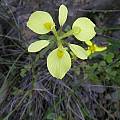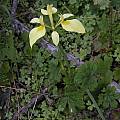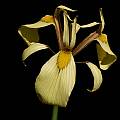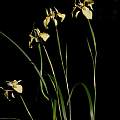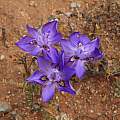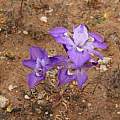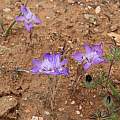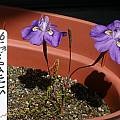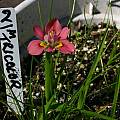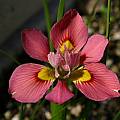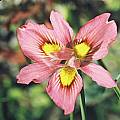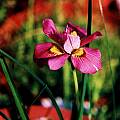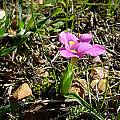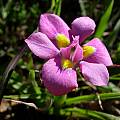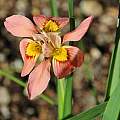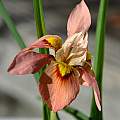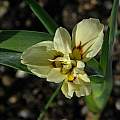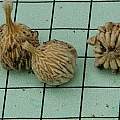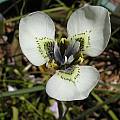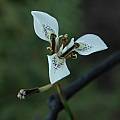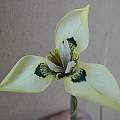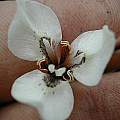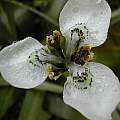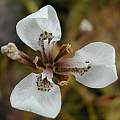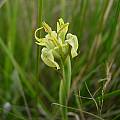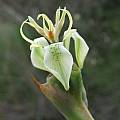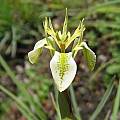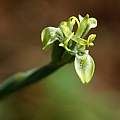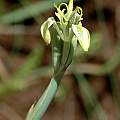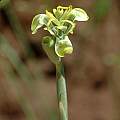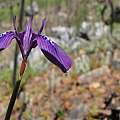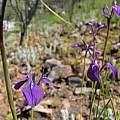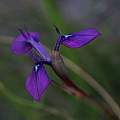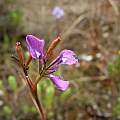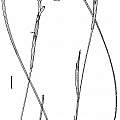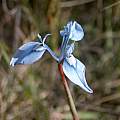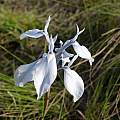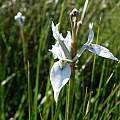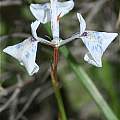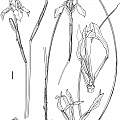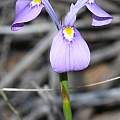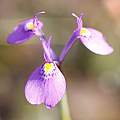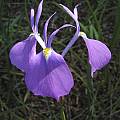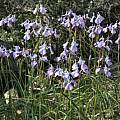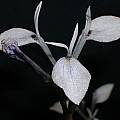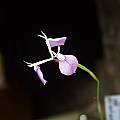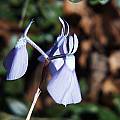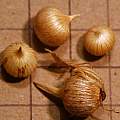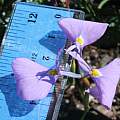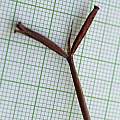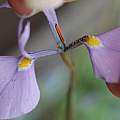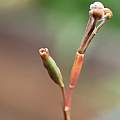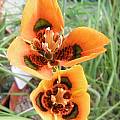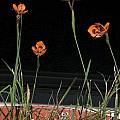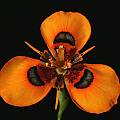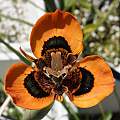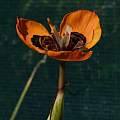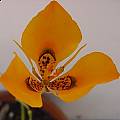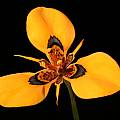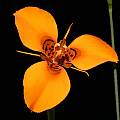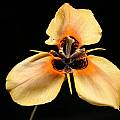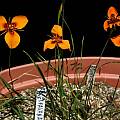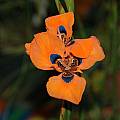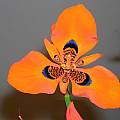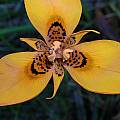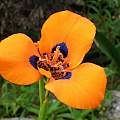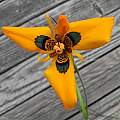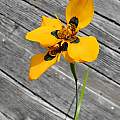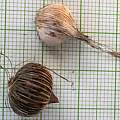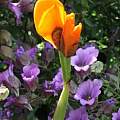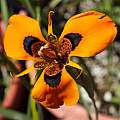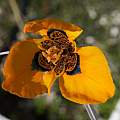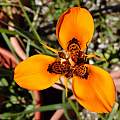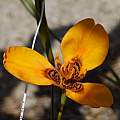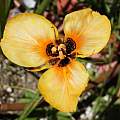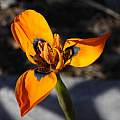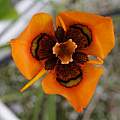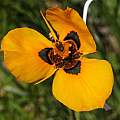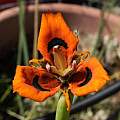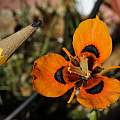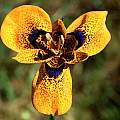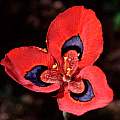The genus Moraea can be divided into five groups: Galaxia, Gynandriris, Hexaglottis , Homeria, and Moraea.
Moraea group species t are found on this wiki page. More information can be learned from Peter Goldblatt's book on Moraeas.
Moraea index lists all the species in all five groups alphabetically.
The other species in the Moraea group are listed alphabetically on these wiki pages: Moraea group a - Moraea group b - Moraea group c-e - Moraea group f - Moraea group g-i - Moraea group j-m - Moraea group n-r - Moraea group s - Moraea group u-v
Moraea thomasiae Goldblatt grows on south-facing slopes in the renosterveld in the Northwest Cape and the Karoo Mountains. It has pale yellow flowers with dark veins and blooms late winter-early spring. The first two pictures were taken by Bob Rutemoeller in September 2003 in the Little Karoo and the last two garden plants were photographed by Bob Werra.
Moraea tortilis Goldblatt is a species from Namaqualand where it is often associated with quartzite outcrops. It has blue or white short lived flowers with reflexed inner tepals and small nectar guides. Leaves are coiled like a corkscrew. The first three photos were taken by Alan Horstmann in Namaqualand in September. The last photo by Bob Werra.
Moraea tricolor Andrews is found on wet sandy flats in the southwestern Cape, flowering in late winter-early spring in the wild. It's best known for having bright pink flowers, but Gordon Summerfield reports that in the wild they can have a wide range of colors, including red, purple, orange, yellow, white, green, and terra cotta. The flowers are short lived but appear over a period of several weeks. They have yellow nectar guides on the outer tepals and are fragrant. Photos by Bob Werra and Alan Horstmann.
Photos taken by Cameron McMaster near Napier in the Overberg show a form without dark maroon edging on the yellow nectar guides.
Photos below were taken by Mary Sue Ittner. The last shows the corms on a 1 cm grid.
Moraea tricuspidata (L.f.) G.J.Lewis is a late blooming moraea that resembles Moraea bellendenii except it is a bit shorter and white. It grows on sandstone, granite, or sometimes clay slopes and is found in quite a few different areas of the Cape. It doesn't always bloom each year for me in cultivation and is reported to bloom well after a fire. Photos by Bob Rutemoeller of one in cultivation and one growing in a wild area of Kirstenbosch National Botanical Garden seen September 2006. The final four photos were taken by Dirk Wallace.
Moraea trifida R.C.Foster is a summer rainfall species that occurs in eastern Southern Africa where it grows in moist grassland. It has a single leaf that is often not longer than the stem and small cream to dull yellow usually unbranched flowers with trilobed inner tepals. Photos 1-3 by Cameron McMaster taken in the Eastern Cape. Photos 4-6 were taken by Mary Sue Ittner and Bob Rutemoeller January 2010 at Naude's Nek.
Moraea tripetala (L.f.) Ker Gawl. is widespread in the western Cape where it grows in a variety of soils. Plants grow from 20 to 45 cm tall, usually with a solitary leaf and with pale blue, purple, or violet flowers with triangular nectar guides, yellow edged with violet, or white dotted with dark blue and edged with darker blue. They have small or missing inner tepals and flower winter to spring (occasionally later.) Three subspecies are recognized. In late 2012 in Systematics of the Hypervariable Moraea tripetala Complex, by Goldblatt & Manning, Bothalia 42, 2., this species was divided into nine species and three subspecies, based on genetics, plant anatomy, and flowering time. For more detailed information about the split, see Moraea tripetala complex.
Moraea tripetala ssp. jacquiniana occurs above 500 m but at lower elevations in the southern Cape Peninsula and grows in rocky sandstone soils flowering mainly November to January, occasionally in October. Growing from 14 to 30 cm tall, it has mostly dark violet tepals with the inner tepals often 5-6 mm long and reaching the bases of anthers. It has white nectar guides spotted with dark blue and edged darker and is unscented. The first two photos from iNaturalist were taken by Nick Helme in November in the southwestern Cape and shared under a CC BY-NC license. The third photo from iNaturalist was taken by Tony Rebelo in January in Table Mountain National Park and shared under a CC BY-SA license. The last photo was taken in November by Cameron McMaster near Napier in the Overberg. Drawing by John Manning shared with his permission from the paper referenced above. Figure notes: Scale bar: 10 mm.
Moraea tripetala ssp. tripetala grows on sandy habitats or coastal limestone, largely in coastal forelands from Aurora on the west coast to Knysna in the east but it also occurs on lower mountain slopes. It has a solitary leaf with pale blue or deep blue or purple tepals, usually with white (or occasionally yellow) nectar guides. Inner tepals are hairlike or absent. Growing 25 to 45 cm tall, it flowers late August to September. The first three photos from Cameron McMaster taken in August and September in the Overberg. The last was taken near Nieuwoudtville in 2009 by Andrew Harvie. Drawing by John Manning shared with his permission from the paper referenced above. Figure notes: A, flowering stems and corm; B, C, inner perianth whorl plus filaments and style; D, seeds. Scale bar: A, 10 mm; B–D, 2 mm.
Moraea tripetala ssp. violacea grows in drier places in clay soils in renosterveld in the Warm Bokkeveld (Ceres), Bonteberg, and Little Karoo It flowers late August to late October and is fragrant, smelling of cloves or carnation. This subspecies is shorter, 20-30 cm tall and sometimes has two leaves. Tepals are violet with yellow velvety nectar guides; the inner tepals are 1-2 mm long, and the pollen is white. The first two photos from iNaturalist were taken by Marion Maclean in August and September in the Little Karoo and shared under a CC BY-NC license.
The photos you see below were formerly named Moraea tripetala, but have not yet been sorted into the new species. Photos by Bob Rutemoeller of garden flowers in Northern California and by Mary Sue Ittner of blooming in 2005 when it bloomed for a long time and abundantly in two Northern California gardens. The third photo of mass bloom was taken by Bob Werra and the fourth photo showing a lighter form was taken by Alan Horstmann. The last two photos taken by Arnold Trachtenberg are of corms donated by Bob Werra in BX 79 and grown under HID lights.
The first photo shows corms from Telos with netted tunics on a 1 cm grid. The second photo uses blue Painter's Tape as a color reference and measures flower diameter at 4 cm. The above-ground parts of three dried plants laid on a 1 cm grid (bold lines are cm) in the third photo show the angular stem shape and single leaf. The fourth photo shows the empty seed pods. In the fifth photo the flower is pulled open to reveal an anther. Because the anthers are pressed tight to the outer tepals, in my garden, unless I open the flower and pollinate by hand, the seed pods do not swell with seeds as seen in the sixth photo. Photos by M. Gastil-Buhl.
Moraea tulbaghensis L.Bolus now includes the species formerly known as Moraea neopavonia R.C.Foster. It is from the northwest and southwest Cape where it grows in clay flats in renosterveld and blooms in spring. This is a rare plant as most of its former habitat has been converted to farmland. Some growers have continued to use the old name to identify plants that closely match its description (see examples below). Both of the former species have orange flowers with speckled centers, but the ones previously identified as M. tulbaghensis have smaller flowers held in a cup shape, longer anthers, and iridescent greenish nectar guides. The former M. neopavonia has larger flat-faced flowers with blue, black, or absent nectar guides. The two species were merged because botanists discovered intermediate forms between the two species, making it impossible to distinguish between them reliably.
The first five photos show the classic M. tulbaghensis form. The first photo was taken by Bob Rutemoeller of plant grown by Gordon Summerfield and the next two by Bob Werra. He admitted he blew on the flower to make the close-up open more fully for his picture. The final two are by Michael Mace, showing the greenish nectar guide and cup-shaped flower.
Photos below show the neopavonia form with its flat flower. The first picture by Lyn Edwards is of one grown in her Canberra garden. The other photos from Bob Werra.
The first photo by Bob Rutemoeller was taken at the August 2006 IBSA meeting. The next three were taken by Alan Horstmann.
The first three photos were taken by Mary Sue Ittner. She writes: "It was in bud for four or five days and I thought it would never open. I finally moved it to a place out of the wind that was warmer and it opened and stayed in bloom for many days afterwards and a second flower opened as well." In June 2012 M. Gastil-Buhl found the two corms shown on a 1 cm grid in photo 4 attached to the stem of the bud opening that March in photo 5.
Here are some other flowers previously classified as M. neopavonia. The nectar guide is sometimes small, black, or absent. The last photo shows a flower with streaks of color in it. This one had faded in the sun for several days; normally it's orange at the center and orange-yellow at the tips, but does not have white streaks. Photos by Michael Mace.
These photos show some intermediate forms. The first two have the form of M. tulbaghensis but blue and chartreuse nectar guides. The third has the M. neopavonia form but a gray-green eye. The fourth is somewhat cup shaped but has a blue nectar guide. And the fifth is flat and has a blue eye like M. neopavonia, but has the size and other characteristics of M. tulbaghensis.
The photos below show some variations seen in the wild by Colin Paterson-Jones. The first photo shows a spotted form, found at De Brug, Western Cape. The second photo is of a red form, which Colin believes is probably a natural hybrid with Moraea villosa. It was found at the Elandsberg Nature Reserve.
Galaxia - Gynandriris - Hexaglottis - Homeria a-j - Homeria k-z - Moraea group a - Moraea group b - Moraea group c-e - Moraea group f - Moraea group g-i - Moraea group j-m - Moraea group n-r - Moraea group s - Moraea group u-v - Moraea hybrids - Moraea index
